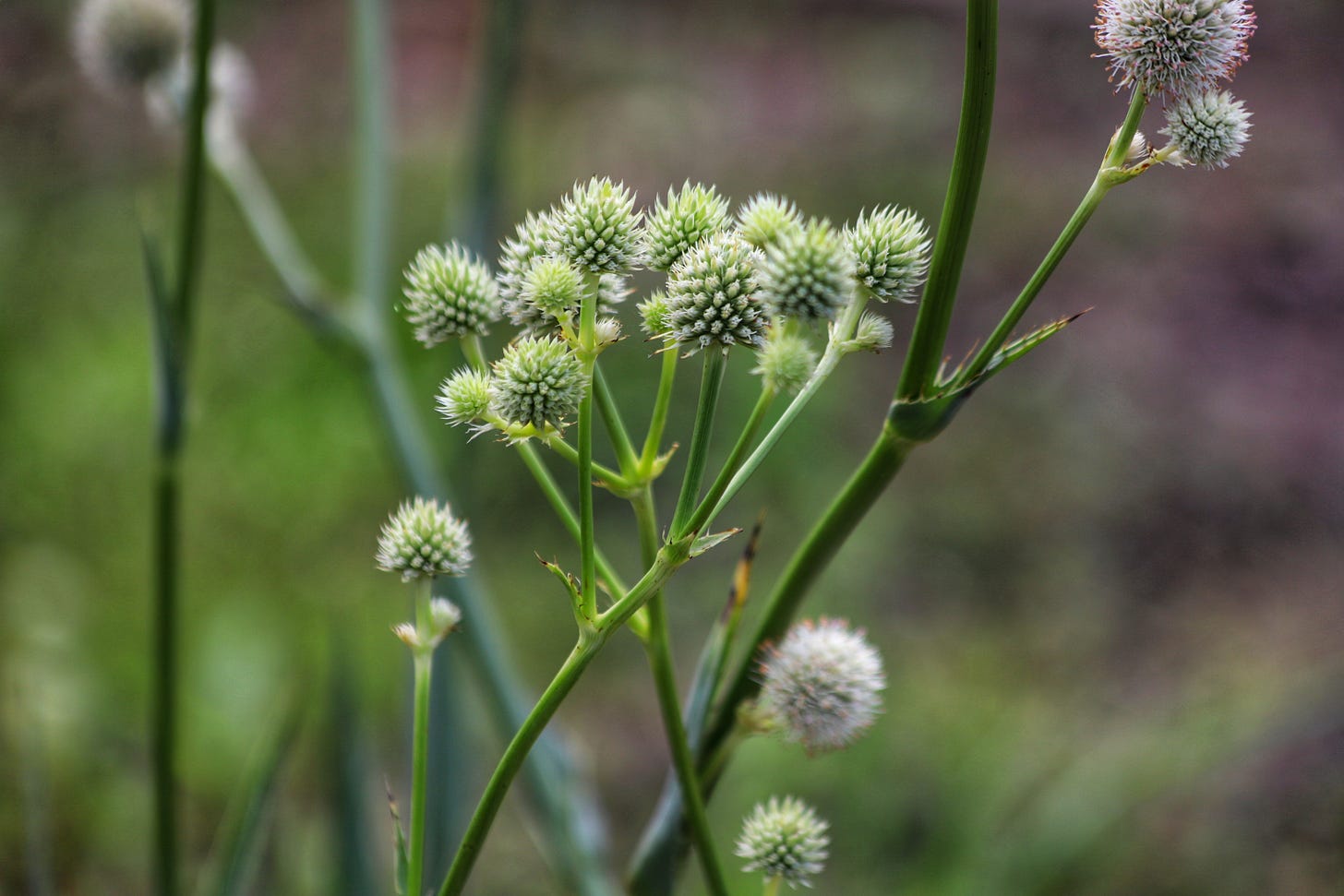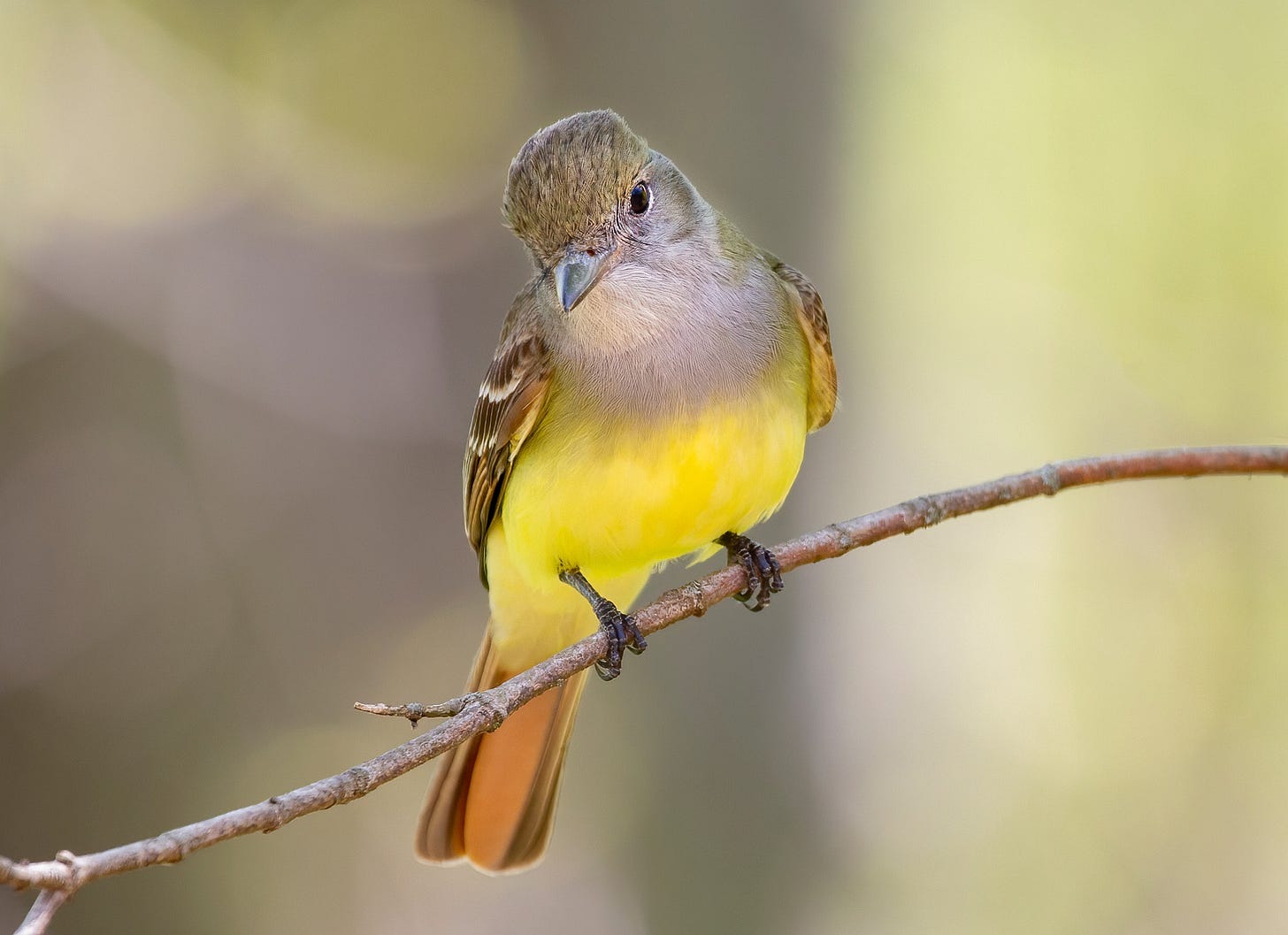We’ve blazed and boomed our way past Independence Day.
So: happy belated, complicated, harrowing, high-noon birthday to the United States of America. Whether you’re feeling depressed, patriotically jacked, or just googling remedies for sudden-onset tinnitus, let’s pause and consider the concept of independence.
Because right now—in the orange-ringed heat haze of breeding season—summer belongs to fledgling birds. Small, feathered thresholds. They tumble from nests, fluttering low across lawns and sidewalks, into a world they don’t yet understand but are curious to meet. Each clumsy hop and half-flight is a gut-check, a sacred stumble toward the vast unknown.
They infuse our timelines with the ache and beauty of first flight—a gesture of escape, yes, but also of arrival. Because even as they strike out on their own, their survival depends entirely on the world they meet: on parents still feeding, branches still sheltering, insects still buzzing, winds still lifting.
Life is not independent. It is utterly dependent. Threaded. Layered. A luminous web of forms, places, pasts, and timescales. Earth, alive and plural, doing its thing.
So yeah, we get it. Cowboy boots are sick. Rugged individualism is romantic—and, under the right conditions, dangerously f--kable. But now let’s get back to celebrating Interdependence Day—which, conveniently, is every day on Earth.
—TNM
UPDATES & ANNOUNCEMENTS
1.) MCGOLRICK BIRD CLUB IS BACK!
Rejoice! We saw you yesterday and we’ll see you again—same Bird-Time, same Bird-Channel. (That’s 9AM, SW corner of McGolrick Park, every Saturday… forever.)
2.) SUMMER SCHOOL!
Our self-proclaimed definitive guide to Summer Sounds is here The Orioles of Summer Index is here A must-read Guide to Herons is here Kingbird Intel → here
MICROSEASON — JUNE 23 - JULY 13
We need a return to the truth we already carry in our bones: That Earth is sacred and alive. That it awaits communion. That noticing—slow, patient, devoted noticing—isn’t a hobby. It’s a practice. A personal liturgy. A silent hallelujah.
To what? To the unifying oneness of life.
Every walk I took. Every bud I watched. Every birdsong I strained to hear. I didn’t do it because it felt good. Or revelatory.
I did it because it was real.
(From The 54 Microseasons of North Brooklyn. Did you read that longy yet?)

This microseason, in McGolrick Park—our urban forest proxy for greater New York City, and even broader swathes of the eastern U.S.—one noticed:
Fireflies peak • Cicadas sing • Wild bergamot, blazing stars, blue vervain, swamp milkweed, obedient plant, rattlesnake master, wild hibiscus, culver’s root, golden alexanders bloom • London planetrees shed
And here’s a full list of McGolrick birds:
Great Crested Flycatcher · Baltimore Oriole · Blue Jay · Chimney Swift · Common Grackle · Downy Woodpecker · Fish Crow · Gray Catbird · Laughing Gull · Northern Cardinal · Red-bellied Woodpecker · White-throated Sparrow · Plus the virtually always present in urban parks: Rock Pigeon, European Starling, American Robin, House Sparrow and Mourning Dove

And in a bit of a twist this week, here’s what was noticed in Prospect Park’s wilder, wetter, roomier landscape this microseason:
American Black Duck · American Crow · American Goldfinch · American Redstart · American Robin · Baltimore Oriole · Barn Swallow · Black-crowned Night Heron · Blue Jay · Brown-headed Cowbird · Canada Goose · Carolina Wren · Cedar Waxwing · Chimney Swift · Chipping Sparrow · Common Grackle · Common Raven · Cooper's Hawk · Double-crested Cormorant · Downy Woodpecker · Eastern Kingbird · Eastern Towhee · Eastern Wood-Pewee · European Starling · Fish Crow · Gray Catbird · Great Blue Heron · Great Crested Flycatcher · Great Egret · Green Heron · Hairy Woodpecker · Hooded Merganser · House Finch · House Sparrow · Laughing Gull · Mallard · Mourning Dove · Mute Swan · Northern Cardinal · Northern Flicker · Northern House Wren · Northern Mockingbird · Northern Rough-winged Swallow · Orchard Oriole · Osprey · Peregrine Falcon · Red-bellied Woodpecker · Red-eyed Vireo · Red-tailed Hawk · Red-winged Blackbird · Ring-billed Gull · Rock Pigeon · Ruby-throated Hummingbird · Short-billed Dowitcher · Song Sparrow · Spotted Sandpiper · Tufted Titmouse · Warbling Vireo · Wood Duck · Wood Thrush · Yellow Warbler · Yellow-crowned Night Heron
Why so many more species in Prospect than McGolrick? Easy: size and water. Birds—like all wild animals—need space to hunt, nest, and raise their young. Prospect offers meadows, woods, a lake, and a chain of ponds. It’s not just a park, it’s a whole suite of habitats. Herons and ducks show up because there’s water. Breeding orioles show up because there’s room. Etcetera.
Don’t let the magic of peaking fireflies fool you: urban fireflies face real threats, from pesticides to light pollution, which can throw off their carefully choreographed mating blinks. If you want to help, experts recommend planting native flora, keeping outdoor lighting to a minimum and leaving leaves (larvae overwinter in leaf litter—yes, really). [source]
London planetree bark “exfoliation” is a year-round, normal, spontaneous occurrence and is beneficial to the health of these long-lasting, resilient trees. [source]
Next North Brooklyn microseason, according to last year’s calendar: Dragonflies peak · Great blue lobelia blooms · Joe-Pye weeds blossom · Sycamore Tussock Moth caterpillars appear (July 15th – 21st)
MUST-KNOW BEACH BIRDS
We continue our Favorite NYC Summerers series with the MUST-KNOW BEACH BIRDS, the ones you're most likely to encounter along the city's edges. (Nota Bene: Give these birds plenty of room—they may be raising young’uns!)
Whether you're actually birding waterside or just stomping around beach blanket circles looking for the public bathroom (while high), these are birds worth recognizing.
American Oystercatcher
Size: Big and bold—larger than a pigeon.
Color: Striking black-and-white tuxedo body, blazing orange bill like a carrot-knife. Yellow eyes with a red ring give it a peculiar expression—equally relaxed or startled.
Similar Species:
Honestly, none. An oystercatcher is an oystercatcher is a... singular bird in NYC. That said, if you’re reading this from the West Coast, keep an eye out for the darker-bodied Black Oystercatcher, a close cousin that lacks the bold black-and-white contrast.
Where in Brooklyn: Coastal only. Look for pairs on mussel beds or tidal flats, stabbing at shellfish.
Killdeer
Size: Just over robin-sized, but leggier and longer-winged.
Color: Notice those two bold black chest bands. Big red-rimmed eyes scream alarmed but glamorous.
Call: Its name is its cry: a piercing kill-deer! that cuts across fields and parking lots like a car alarm that’s actually worth your attention.
Similar Species:
Piping Plover – Also sandy and round, but smaller, paler, and only one breast band.
Where in Brooklyn: Look (and listen) for killdeers around open, gravelly spaces—edgy habitats like ballfields or even flat rooftops near the coast. They’re noisy flyovers and possible to clock all over. Just be sure to distinguish from Northern Mockingbirds who live seaside—they love to mimic them.
Willet
Size: One of the beefier shorebirds—chunky, straight-billed, and about the size of a crow. No nonsense, all-business silhouette.
Color: Plain gray-brown overall, but with a dazzling secret: in flight, bold black-and-white wing stripes flash like emergency lights (see above). Summer birds are subtly scaled and streaky; winter birds go smoother and grayer. Pay special attention to their gray leg color to distinguish them from similar shorebird species.
Call: A loud, ringing pill-will-willet!—a yodel that carries over salt marshes.
Similar Species:
Greater Yellowlegs – Taller, more slender, with a longer, slightly upturned bill and obvious yellow legs.
Lesser Yellowlegs – Looks similar in photos but is daintier and calls very differently.
Short-billed Dowitcher – More compact with a very long, straight bill. Feeds with a sewing-machine motion.
Where in Brooklyn: Check the saltier edges—Jamaica Bay Wildlife Refuge is your best bet, especially near the West Pond. Almost always near water, willets walk deliberately like they have somewhere important to be, and probably do.
Least Tern
Least Terns fly with rapid wingbeats—light and agile, like windblown paper. They often hover before plunging into the water for fish, like angry little kites. Get too close to their nest, and they will dive bomb your stumblin’ a--.
Size: Small, and all wing. The smallest tern in North America. Like someone shrunk a gull and hit “fast forward.”
Color: Mostly white, with a sharp black cap and crisp white forehead. Yellow legs and a dainty yellow bill with a black tip—like a cartoon pencil. The bold contrast of the black crown and white brow is key.
Call: High-pitched kip-kip-kip! or sharp, squeaky zeep!—sounds like it’s arguing with gravity while hovering.
Similar Species:
Common Tern – Larger, with a darker cap that extends all the way to the bill—no white forehead. Also has a red-orange bill and legs.
Where in Brooklyn: Look for leasts along the beaches of Plumb Beach or Breezy Point. They nest on (usually protected) open sand, and dive for fish just offshore.
This is just the tip of a reasonably sized shorebird spear. But these four are you-can-learn-’ems: distinctive, frequently seen, and—let’s be honest—HOT.









